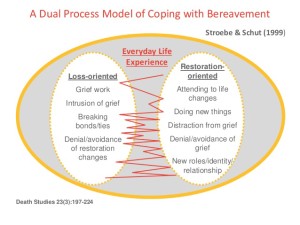Experiencing significant loss through the death of a friend or loved one can be extremely difficult! Those who’ve traveled this journey may have wondered if their grieving was considered typical or not.
While grief is not predictable, and hardly ever feels “normal,” most of us have the resiliency to make it through the experience. Along the way, we’ll feel a variety of emotions that are uncomfortable, intrusive, and undesirable. The pain we experience can seem unbearable! But while the loss itself is permanent, the intensity of it all will lessen over time.
Perhaps you have heard of The Five Stages of Grief (Denial, Anger, Bargaining, Depression, and Acceptance). This model was created in 1969 by Dr. Elisabeth Kübler-Ross, a Swiss-American psychiatrist. Originally, Dr. Ross studied terminally ill patients for their response and emotions to knowing they would die. But somewhere along the way, that model was adapted for those who are grieving the loss of someone they love rather than for the person who is terminally ill. This model of grief can make it seem like once you have worked through all these stages/feelings and have reached “acceptance,” then you will no longer experience pain in your loss.
A few months ago, I had the opportunity to attend a conference on grief. I was so encouraged to learn about a newer grief model. It’s called the Dual Process Model of Coping with Bereavement and was developed in 1999 by two researchers who studied grief and loss over many years. The model describes grief as a natural process and helps us find the balance between facing the reality of our loss with learning to engage with life after loss.
This back and forth “balancing act” explains why many of us who are grieving feel like we’re on an emotional roller coaster. This, too, is considered normal. Some of the loss-oriented responses include crying, thinking about your loved one, attending grief counseling, and having a strong desire to isolate and not make any changes. Restoration-oriented responses include learning to do something new like cooking, paying the household bills, making new friendships, and taking on roles your loved one may have left vacant. During restoration-oriented activities, you’re able to focus on day-to-day tasks, like going to work or cleaning the house that provides at least temporary relief from the emotional drain of your loss.
When I’ve explained this newer model to some of my clients, they’ve mentioned how knowing they will oscillate between these two responses helps them feel less distressed about their situations. Also, knowing that others are doing the same thing after a loss makes it seem less frightening and isolating.
Nearly 10% of people facing loss will experience complicated grief, which can be helped by working with a therapist. Complicated grief occurs when a reaction to bereavement is extremely strong, long-term, and debilitating. If you feel like you may be experiencing this type of grief, find a grief counselor or therapist who can give you one-on-one support during this difficult time.
Most people, however, have a normal grief experience. Moving back and forth in the Dual Process of Grief is part of a typical reaction to loss. Being aware of when you are experiencing loss-oriented emotions and engaging in restoration-oriented activities will help you normalize your own grief experience.
If you need help dealing with your grief journey, contact The BabbCenter for Counseling to schedule an appointment (615-824-3772). Also, you may consider attending our next group session of Journey Through Grief.


